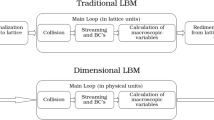Abstract
Starting with the kinetic theory for dilute solid/liquid two-phase flow, a mathematical model is established to predict the flow in a horizontal square pipe and the predictions are compared with LDV measurements. The present model predicts correctly two types of patterns of the vertical distribution of particle concentration observed in experiments, and also gives different patterns of the distribution of particle fluctuating energy. In the core region of the pipe, the predicted mean velocity of particles is smaller than that of liquid, but near the pipe bottom the reverse case occurs. In addition, full attention is paid to the mechanism for the vertical distribution of the average properties of particles such as concentration and mean velocity. From the kinetic-theory point of view, the cause of formation for different patterns of the vertical concentration distribution is not only related to the lift force exerted on a particle, but also related to the distribution of particle fluctuating energy.
Similar content being viewed by others
References
Liu Dayou, Fluid Dynamics of Two-Phase Systems (in Chinese), Beijing: Higher Education Press, 1993.
Ni Jinren, Wang Guangqian, Zhang Hongwu, Basic Theories of Solid-Liquid Two-Phase Flows and Their Recent Applications (in Chinese), Beijing: Science Press, 1991.
Wang, G. Q., Ni, J. R., The kinetic theory for dilute solid/liquid two-phase flow, Int. J. Multiphase Flow, 1991, 17: 273.
Wang Guangqian, Ni Jinren, Kinetic theory for particle concentration distribution in two-phase flow, J. Eng. Mech., 1990, 116: 2738.
Ding, J. M., Gidaspow, D., A bubbling fluidization model using kinetic theory of granular flow, AIChE Journal, 1990, 36: 523.
Louge, M. Y., Mastorakos, E., Jenkins, J. T., The role of particle collisions in pneumatic transport, J. Fluid Mech., 1991, 231: 345.
Cao, J., Ahmadi, G., Gas-particle two-phase turbulent flow in a vertical duct, Int. J. Multiphase Flow, 1995, 21(6): 1203.
Jenkins, J. T., Savage, S. B., A theory for the rapid flow of identical smooth, nearly elastic, spherical particles, J. Fluid. Mech., 1983, 130: 187.
Rizk, M. A., Elghobashi, S. E., On the motion of a, spherical particle suspended in a turbulent flow near a plane wall, Phys. Fluids, 1985, 28: 806.
Crowe, C. T., Sommerfeld, M., Tsuji, Y., Multiphase Flows with Droplets and Particles, Florida: CRC Press, 1998.
Owen, P. R., Pneumatic transport, J. Fluid Mech., 1969, 39: 407.
Wang Guangqian, The kinetic theory with experimental studies for the solid/liquid two-phase flow and granular flow, Ph. D. Thesis, Department of Hydraulic Engineering, Tsinghua Univ., Beijing, China, 1989.
Gidaspow, D., Multiphase Flow and Fluidization: Continuum and Kinetic Theory Descriptions, San Diego: Academic Press, 1994.
Koch, D. L., Kinetic theory for a monodisperse gas-solid suspension, Phys. Fluids A, 1990, 2: 1711.
Peirano, E., Leckner, B., Fundamentals of turbulent gas-solid flows applied to circulating fluidized bed combustion, Prog. Energy Combust. Sci., 1998, 24: 259.
Jenkins, J. T., Boundary conditions for rapid granular flow: flat frictional walls, J. Appl. Mech., 1992, 59: 120.
Dou, G. R., Turbulence (II) (in Chinese), Beijing: Higher Education Press, 1987.
Kulick, J. D., Fessler, J. R., Eaton, J. K., Particle response and turbulence modification in fully developed channel flow, J. Fluid Mech., 1994, 277: 109.
Alajbegovic, A., Assad, A., Lahey, R. T. Jr., Phase distribution and turbulence structure for solid/fluid upflow in a pipe, Int. J. Multiphase Flow, 1994, 20(3): 453.
Lee, S. L., Durst, F., On the motion of particles in turbulent duct flows, Int. J. Multiphase Flow, 1982, 8: 125.
Van de Wall, R. E., Soo, S. L., Measurement of transport properties of a gas-solid suspension using phase Doppler anemometry, Powder Technology, 1997, 94: 141.
Author information
Authors and Affiliations
Rights and permissions
About this article
Cite this article
Fu, X., Wang, G. & Dong, Z. Theoretical analysis and numerical computation of dilute solid/liquid two-phase pipe flow. Sci. China Ser. E-Technol. Sci. 44, 298–308 (2001). https://doi.org/10.1007/BF02916707
Received:
Issue Date:
DOI: https://doi.org/10.1007/BF02916707




